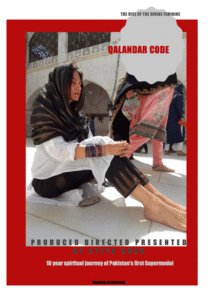Documentary Film Review: Qalandar Code
By Shanaz Ramzi | Movies | Published 7 years ago

In case you are wondering about the title of the recently released Atiya Khan documentary, Qalandar Code, think Da Vinci Code, and it may make sense. This is unveiled as a spiritual journey, in the course of which Khan implies, she managed to unlock the age-old secrets ensconced within Lal Shahbaz Qalandar’s shrine. After seeing the documentary, however, what became visible was the fact that this film was more about Khan’s personal spiritual enlightenment – there were plenty of scenes to indicate that – than unravelling the mystery of Qalandar, if indeed one exists. I was not convinced about the soundness of the conclusions drawn by Khan at the end of her spiritual quest.
Khan announces she discovered through her seeking that the shrine is not just a haven that transcends time and place, where all differences of caste, creed and religion melt into ‘Divine Unity,’ but also that it holds the key to the secret of Bibi Fatima, the Prophet (pbuh)’s daughter: her escape to a sacred cave in Balochistan. This cave, she asserts, “is believed to be the new Kaaba and the place of return of The Mahdi.” Almost startlingly, she says, on this journey to discover the truth, she arrives at the conclusion that The Mahdi – as she prefers to refer to the identity of the awaited messiah (the twelfth imam in Shiite belief who had disappeared and is supposed to reappear from a cave before the Day of Judgement, along with Jesus Christ) – is actually Bibi Fatima Zehra. She also links the concept of the ‘Divine Feminine’ in other religions with Bibi Fatima, concluding that she is ‘The Mahdi’ who will reappear from this very cave.
While the viewer may be sceptical about the conclusions drawn by Khan, linking the daughter of the Prophet (pbuh) to the messiah Mahdi, it has to be said that the documentary is, nonetheless, interesting, and renders some surprising factual revelations, such as the existence of this sacred, remote cave up in the mountains in Balochistan. The cave is believed to have been Bibi Fatima’s home, where Khan feels, as indeed do the malangs of Qalandar and many others who live around that area, that Bibi Fatima was taken there secretly after her house had been burnt down following the death of the Prophet (pbuh), and lived there till she passed away.
Tracing Islamic history, Khan also relates her understanding of a part of history that most people are not aware of, and which many would probably find quite unpalatable. She recounts how Hazrat Umar, bent on securing the allegiance of Ali and Fatima to Abu Bakr’s post of caliph after the Prophet (pbuh)’s death, was responsible for burning down the door of Fatima’s, house when she refused to open it, since her husband was not home. She adds that in the mayhem that followed Bibi Fatima, who was pregnant at the time, was injured, and later had, it was generally believed, succumbed to her injuries. However, as she did not wish those who had inflicted this suffering on her to seek forgiveness at her grave, she requested that she be buried secretly in the middle of the night.
Khan explains that there are many, however, who believe that Fatima did not die that night, but was whisked away in the darkness to this cave, which had been presented to her by her father. The Prophet (pbuh)’s prayer mat is said to be lying there even today. So it is disappointing that this sacred cave, which is described in the documentary in such detail by the malangs, is not shown to the viewer in much depth – even though Khan had visited it not once, but twice.
Nor does Khan enlighten us when she makes the challenging climb up to the cave as to whether she discovered the lion, camel and snake around it that the malangs told her are to be found there.
Not that Khan takes at face value whatever the malangs at the shrine tell her. The viewers see her sceptically, even mockingly, asking the same questions that pop into their own minds – how did Bibi Fatima traverse such a great distance from Madina to arrive here? Of all places, why was this one selected – and so on. But while the viewer may not have been convinced by the explanations, Khan obviously is.
All that aside, Qalandar Code tackles a bold and controversial subject, and one must hand it to Khan for being brave enough to take up the challenge, tread in areas where few would dare to venture, and voice her opinions, no matter how out- of-the-box, without reservation.
The writer is a freelance journalist based in Karachi. She also works at Hum television.


